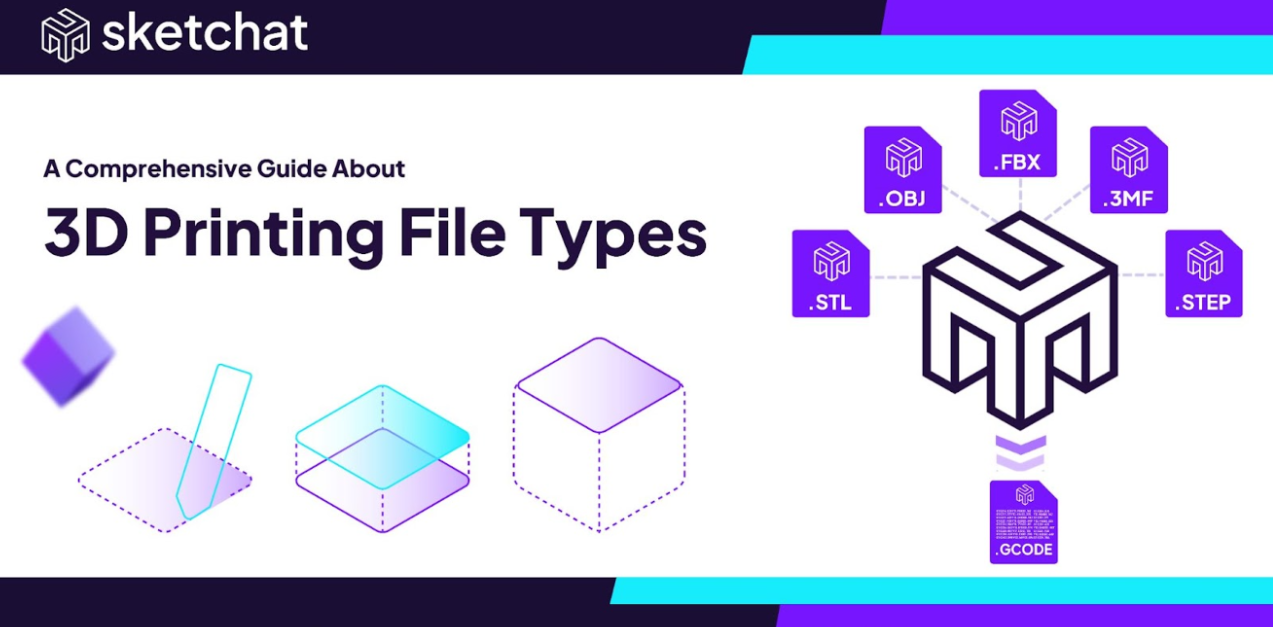
The first thing anyone encounters when entering the world of 3D printing is the variety of file formats, which can seem a bit confusing at first. Choosing the right file format for your 3D printer is as important as selecting the material (which we cover in two other blog posts), as this step ensures smooth printing.
Since you're here, get ready to become a 3D printing expert by the end of this article. Below, you'll learn about different 3D file formats, their advantages, and how to choose the best file type for printing based on your needs — whether you're creating a model for a resin printer or working with an FDM printer.
Types of 3D Printing Files
Before diving into specifics, let’s understand what 3D printing file formats are. These are digital blueprints that a 3D printer uses to create a physical object. The file format contains all the necessary information about the model, such as its geometry, color, texture, and how it should be printed layer by layer. Each type of 3D file serves different purposes, depending on the printing method and printer used.
Common 3D Printing File Types
Let’s go over some of the most common 3D model file types you may encounter in the world of 3D printing, and you're probably already familiar with some of them.
STL File Format
The most common format in 3D printing, especially for FDM printers. STL files contain the geometry of a 3D object in the form of a triangular mesh. While they don’t store information about color or texture, they are perfect for creating simple, accurate prints.
OBJ File Format
The OBJ file format is used for 3D models with textures and color data, making it a good choice for detailed models. It is compatible with many 3D modeling programs and 3D printers. However, it’s not as efficient as STL for most 3D printing tasks due to the larger file size.
Additionally, MTL files are usually used with OBJ files to store material properties. If you are working with OBJ files and want to apply different materials (e.g., metal, wood, or plastic), you will need an MTL file to define how the surface should appear in terms of texture and color.
FBX File Format
FBX files are generally used in animation and film production. While not often used for 3D printing, they are still supported by some programs for complex models that require animation or detailed rigging.
3MF File Format
This modern file format was created specifically for 3D printing. It allows you to transmit not only geometry — 3MF files can include data on color, texture, and material, making them ideal for high-quality, detailed prints.
GCODE Files
Unlike other formats, GCODE files for 3D printers are not model files but instructions that tell the 3D printer how to print the object. After creating a model in a CAD program, you convert it into GCODE using slicing software.
Resin Files
As for resin printers, you need special resin 3D printer files. These files are often delivered in the form of STL files intended for high-precision layer-by-layer printing with ultraviolet-sensitive resin.
Choosing the Best File Type for 3D Printing
And here’s my favorite question: "What’s the BEST file type for printing? “ I’ll answer briefly: it all depends on the printer and the specific needs of your project. Different 3D printers and projects require different types of files for optimal performance, so understanding which file formats best suit your situation is key to achieving the best results.
Below, we’ll explain what you should consider when choosing a file type.
Best File Type for Printing For most 3D printing projects, my colleagues and I usually choose STL files (especially for FDM printers). They are the standard and most widely used file format.
Why?
Because STL files are simple and compatible with almost all 3D printers. They only contain geometric data (shape and size of the object), which makes them ideal for basic printing tasks. Whether you're printing a simple prototype or a complex model, STL files typically do the job.
Example:
If you're printing a small figure or an everyday item like a phone stand using an FDM 3D printer, STL will likely be the best choice because the model is simple and doesn’t require additional details like textures or colors.
However, when working with highly detailed models or resin printers, more advanced file formats may be needed. Formats like OBJ or 3MF are more versatile and can carry additional information, such as color, texture, and even material properties, making them ideal for printing detailed models or multi-material prints. For creating detailed character models with textures or colors, such as prototypes for cosmetic products, it’s better to use OBJ files. They allow you to include intricate details that cannot be conveyed in STL files.
For Resin Printers
When printing with resin 3D printers, accuracy is key. Resin printers operate differently from FDM printers, using ultraviolet light to cure layers of resin. To ensure precision and quality, specialized resin-specific files are required.
Resin STL Files
Many resin printers accept STL files, but some require specialized files optimized for resin printing. These files ensure better accuracy needed for fine details and correct alignment of each layer.
If you’re creating small, detailed jewelry or figurines, using an STL file for resin printing is the best option. This helps the resin printer achieve finer details that are hard to achieve with FDM printers.
For CAD Projects
If you’re an engineer or designer working with CAD software, you’ll often use specialized CAD file formats like STEP or STP. These file types are more complex than STL and are used for detailed engineering models. They store not just geometry, but also material properties, dimensions, and assembly details.
These files are necessary for industrial 3D printing or when a design requires precise technical specifications that cannot be conveyed with STL files. For example, CAD formats are used to create mechanical parts or products that must fit together in a particular way.
STEP Files
In industries such as aerospace or automotive, STEP files are especially useful, as models often need complex internal structures or materials that interact with one another. A STEP file can store this data, allowing manufacturers to print parts with accurate specifications.
Using CAD formats like STEP or STP ensures that all complex measurements and technical details are preserved throughout the printing process. This is especially noticeable when designing mechanical parts like gears or engines, where accuracy is critical for the proper functioning of the part.
File Types - Which One to Choose? STL vs Other File Formats
The debate over which file format is best for specific 3D printing tasks is endless. However, we’re at a point where we can make conclusions. Primarily, it depends on what you’re printing, what printer you're using, and how complex your project is.
In this section, let’s explore some of the most common file format comparisons to help you make a more informed choice:
STL vs OBJ
STL and OBJ are both very popular file formats, but they serve different purposes. As I mentioned earlier, STL files are suitable for simple 3D printing based only on geometry.
They’re easy to work with and compatible with almost all 3D printers. However, STL files lack support for textures, colors, and materials. On the other hand, OBJ files are better suited for more detailed models that require texturing or coloration. If you are printing a figurine and want to include color and texture, OBJ files are the ideal choice. But if you are creating a simple 3D model of a tool or mechanical part, STL files are usually a better option.
STL vs FBX
STL and FBX are both widely used for creating 3D models, but they serve different purposes, especially when it comes to animation and 3D printing:
FBX file format is ideal for 3D models that require complex animation or rigging, similar to OBJ files, making it popular in the gaming and film industries. It supports detailed textures, animation data, and complex 3D models. However, FBX is not ideal for 3D printing, as it is more suited for dynamic scenes than static objects. STL files are better suited for static models that don’t require animation or rigging. When it comes to 3D printing, STL files are the better choice.
If you’re creating a 3D model of a chair for printing on an FDM 3D printer, STL is typically the preferred format. FBX would be overkill unless you're planning to animate the chair in a game or movie.
STL vs 3MF
STL files are the most commonly used file type for 3D printing due to their simplicity and wide compatibility. However, remember that they only store basic geometric data and do not support color, material, or other complex properties. 3MF is a more advanced file format that supports additional data, such as color, material information, and print settings. This makes 3MF files suitable for advanced 3D printing projects that require more flexibility and complexity.
For example, 3MF can handle prints made from multiple materials or prints with fine details, such as objects with several colors. For a project where you are printing an object with multiple materials (such as a figurine with different colored parts), the 3MF format is preferable. If it’s just a basic object that doesn’t require color or texture, STL is still a great option.
STL vs STEP
This comparison involves engineering accuracy versus simplicity and general use:
STEP (or STP) files are widely used in engineering and manufacturing, as they support complex geometry and provide highly accurate 3D representations of objects. These files can store not only geometry but also material properties, assembly instructions, and other production details. STEP is needed for projects requiring high precision, such as mechanical parts or industrial samples.
STL files, on the other hand, are much simpler and are the go-to choice for 3D printing due to ease of use. They only contain geometric data (the external shape of the model) and lack any material or internal feature information. While STL is sufficient for many 3D printing applications, it lacks the complex data that STEP files provide for precision parts. When designing a custom gear that must fit with other parts precisely, you’d be better off using a STEP file. If you’re printing a simple decorative model, such as a small sculpture, STL will suffice.
Well, that’s almost everything! Now you’re closer than ever to making the right choice. Understanding the differences between these file types for 3D printing will significantly help you achieve the best results.
Whether you're printing a simple model, working with complex engineering designs, or creating highly detailed resin prints, choosing the right format will help you get the best results.










